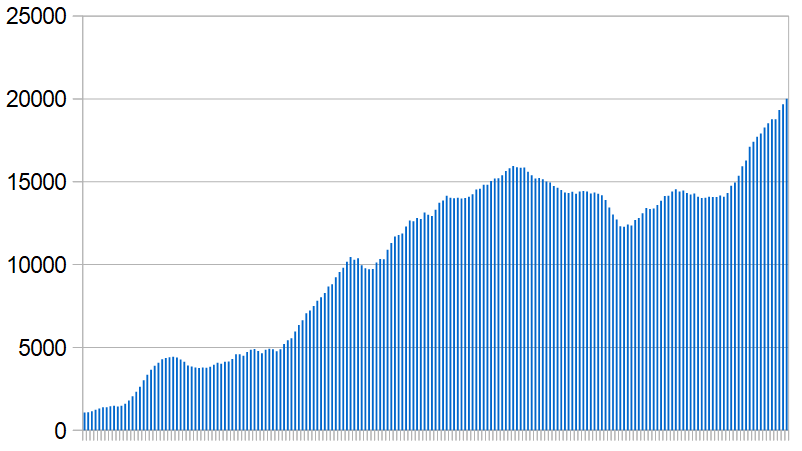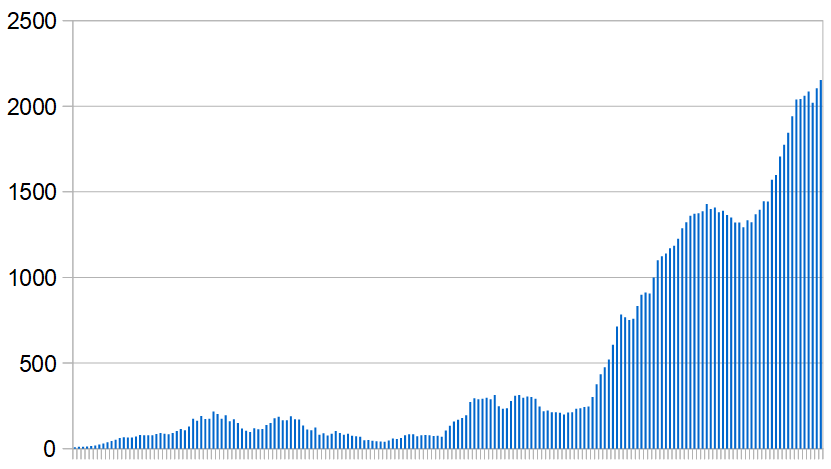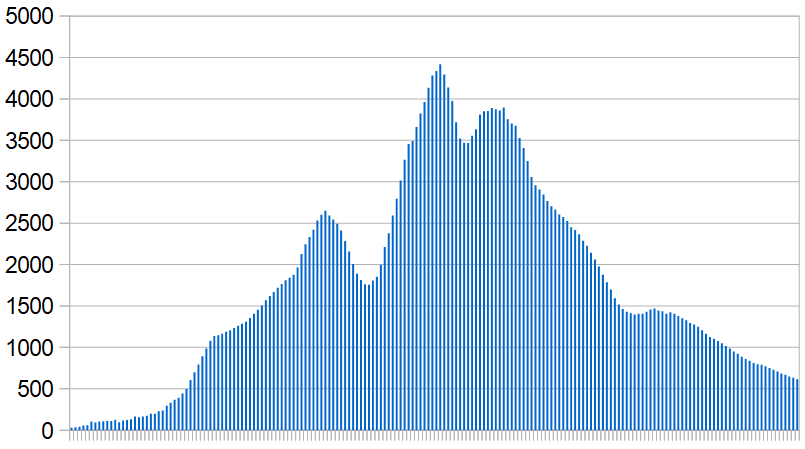Week ending 19 September 2020
REGIONAL OVERVIEW
 |
Covid-19 infections in the Middle East and North Africa continue to rise. The total of new cases across the region, which was averaging around 15,000 a day at the start of this month, is now around 20,000 according to the official figures.
Most countries in the region took swift action when the virus first arrived and for a while seemed to be having some success in slowing its spread. Six months on, though, many of them are struggling to hold the line, partly because of the economic effects of preventive measures.
Bahrain, Israel, Jordan, Lebanon, Libya, Morocco, Palestine and Tunisia all reported record numbers of new infections this week. Israel's one-week total of more than 30,000 new cases was the highest in the region and it has now become the first developed country to declare a nationwide lockdown for the second time.
Detailed statistics for the region, based on official figures, can be found in this spreadsheet.
Previous situation reports: September 12; September 5; August 29; August 22; August 15; August 8; August 1; July 25; July 18; July 11; July 4; June 27; June 20.
ALGERIA
Algeria's outbreak peaked towards the end of July when more than 600 new infections were being recorded each day. Since then the trend has been downwards, with new cases averaging 237 a day during the past week according to official figures.
For more information see: Covid-19 in Algeria
Confirmed cases: 49,413
New cases in past week: 2,019
Active cases: 12,936
Deaths: 1,659
Tests carried out: (unknown)
BAHRAIN
 |
Since the outbreak began Bahrain has recorded more than 37,000 cases per million inhabitants. This makes it the world's second most infected country after Qatar. However, Bahrain is also one of the world leaders in Covid-19 testing. So far, about two-thirds of its 1.7 million population have been tested.
Until recently Bahrain's epidemic appeared to be gradually subsiding but new infections have risen since the beginning of September, averaging 720 a day this week – the highest level since the outbreak began.
On Thursday, 34 people were ordered to pay fines ranging from 1,000 to 3,000 dinars ($2,650–$7,960) for violating home quarantine. Their offences were reportedly detected by Bahrain's electronic monitoring system.
Cafes and restaurants reopened for outdoor dining earlier this month but the resumption of indoor dining has been postponed until October 24. The return of in-person teaching in state schools has also been postponed until October 11.
Bahrain is taking part in trials of a Covid-19 vaccine on behalf of the Chinese company Sinopharm, and Crown Prince Salman bin Hamad was among those vaccinated on Wednesday.
For more information see: Covid-19 in Bahrain
Confirmed cases: 63,879
New cases in past week: 4,744
Active cases: 6,959
Deaths: 220
Tests carried out: 1.3 million
EGYPT
According to the Egyptian authorities, new infections this week averaged 152 a day compared with almost 1,600 a day at the peak in June. The official figures are surprisingly low considering Egypt's large population (103 million) and the often crowded living conditions.
It's also unclear how many tests are being carried out because the government has not issued any figures since May when the total stood at 135,000 tests.
Whether or not the official statistics are true, anecdotal evidence does suggest the number of new cases has dropped considerably. One indication of that was the trade ministry's announcement this week that sanitising products, face masks, latex gloves and other protective equipment can be exported. Exports of these items were originally banned in March but Egypt now has more of them than it needs.
Egypt is joining the Covid-19 vaccine trials currently taking place in the UAE, Bahrain and Jordan.
For more information see: Covid-19 in Egypt
Confirmed cases: 101,772
New cases in past week: 1,126
Active cases: 8,081
Deaths: 5,733
Tests carried out: 135,000
IRAN
Iran was the first country in the region to be seriously affected by the virus. Government figures show an initial wave of infections which peaked at the end of March. It subsided during April, briefly dipping below 1,000 new cases per day but then rose to another peak, touching almost 3,000 a day in the first week of June. This week's average was 2,628 a day.
Iran continues to report more coronavirus-related deaths than any other country in the region.
Confirmed cases: 416,198
New cases in past week: 15,029
Active cases: 36,741
Deaths: 23,952
Tests carried out: 3.7 million
IRAQ
 |
Iraq's official figures are widely believed to understate the scale of the epidemic. Many cases go unreported because of social stigma. Compliance with preventive measures appears to be low and health services are inadequate.
For the last two weeks new cases have been averaging more than 4,000 a day. This is said to be partly a result of increased testing.
For more information see: Covid-19 in Iraq
Confirmed cases: 311,690
New cases in past week: 30,597
Active cases: 57,977
Deaths: 8,408
Tests carried out: 2.0 million
ISRAEL
 |
After coming close to bringing the epidemic under control, Israel has been hit by a second wave much larger than the first. The first wave peaked at around 600 new cases a day in early April. Efforts to control it were intially successful and by the second half of May new cases had dropped to about 15 a day.
However, the virus surged back when lockdown restrictions were lifted. New infections this week were the highest so far, averaging 4,358 a day – more than double the level of two weeks ago. Considering Israel's small population this is a very high infection rate, equivalent to 157,000 cases a day in a country the size of the United States.
On Friday, coinciding with Rosh Hashanah (the Jewish New Year holiday) Israel embarked on its second nationwide lockdown, which is due to last for at least three weeks. Details of the restrictions are here. They include a rule that people must not venture more than 500 metres from their home.
There is a lot of public opposition to the lockdown and compliance is likely to be a problem.
For more information see: Covid-19 in Israel
Confirmed cases: 179,071
New cases in past week: 30,507
Active cases: 47,851
Deaths: 1,196
Tests carried out: 2.9 million
JORDAN
For several months Jordan appeared to be the most successful Arab country in controlling the virus. Transmission within Jordan had virtually ceased and almost all the new cases were detected among people arriving from abroad.
Since then, however, community transmission has returned with a spate of locally-occurring infections. New cases this week averaged 200 a day – the highest level so far.
The prime minister said on Wednesday that Jordan will not return to a full-scale lockdown but a range of new restrictions has been announced (details here). Violators face penalties ranging up to a year in jail or a fine of 1,000 dinars ($1,400).
Schools have been switched to distance learning for the next two weeks following a series of infections among teachers and students.
For more information see: Covid-19 in Jordan
Confirmed cases: 4,344
New cases in past week: 1,399
Active cases: 1,084
Deaths: 29
Tests carried out: 1.0 million
KUWAIT
New infections peaked in late May at just over 1,000 cases a day. Although the numbers have dropped back substantially since then, the current level is higher than it was at the end of August. New cases this week averaged 722 a day.
For more information see: Covid-19 in Kuwait
Confirmed cases: 98,528
New cases in past week: 5,053
Active cases: 9,172
Deaths: 580
Tests carried out: 700,000
LEBANON
Political and economic turmoil, plus the devastating explosion in Beirut on August 4, have diverted attention from the coronavirus. Lebanon's outbreak is still relatively small, though the number of confirmed cases has almost trebled during the past month.
The sharp rise during August led to a rather half-hearted two-week lockdown. That briefly stabilised the spread of infections but this week has seen further increases with new cases now averaging 648 a day.
For more information see: Covid-19 in Lebanon
Confirmed cases: 27,518
New cases in past week: 4,535
Active cases: 16,498
Deaths: 281
Tests carried out: 701,000
LIBYA
Libya is in its tenth year of internal conflict. The UN-backed Government of National Unity in Tripoli is challenged by Field Marshall Haftar's forces based in the east of the country. There are also numerous militias. This leaves the country ill-equipped to cope with a major epidemic.
Growing levels of insecurity, political fragmentation and weak governance have led to a deterioration of basic services, particularly in the health system. At least 27 health facilities have been damaged or closed by fighting and some have been attacked directly. There are 870,000 people – refugees, asylum seekers and displaced persons – who the UN regards as especially vulnerable.
According to the official figures Libya's outbreak is still relatively small but the total of confirmed Covid-19 cases has more than doubled over the last three weeks. New infections recorded this week averaged 647 a day.
A UN report issued this week said:
"Persistent and acute shortages in Covid-19 testing capabilities and supplies, along with adequate health care facilities and contact tracing means the true scale of the pandemic in Libya is likely to be much higher ...
"Increasing numbers of health care staff are contracting Covid-19 due to a lack of personal protective equipment."
The report also hinted at a lack of coordination between the ministries of health and the National Centre for Disease Control (NCDC) and called for a clearer understanding of "where and how Covid-19 funds announced by Libyan authorities have been spent".
For more information see: Covid-19 in Libya
Confirmed cases: 26,438
New cases in past week: 4,530
Active cases: 11,813
Deaths: 418
Tests carried out: 176,000
MOROCCO
 |
By early June a strict lockdown had reduced new cases in Morocco to around 40 a day. Since then, though, there has been a severe setback and new cases are running at record levels. This week's average was 2,152 a day.
It was reported this week that Covid-19 testing capacity has been increased by the inclusion of 18 private laboratories in the testing system.
For more information see: Covid-19 in Morocco
Confirmed cases: 97,264
New cases in past week: 15,067
Active cases: 18,819
Deaths: 1,755
Tests carried out: 2.3 million
OMAN
Infections peaked in mid-July with just under 1,600 cases a day. The numbers dropped back considerably in August but have since been rising again. This week's average was 488 new cases a day compared with 280 a day during the previous week.
For more information see: Covid-19 in Oman
Confirmed cases: 91,753
New cases in past week: 3,416
Active cases: 6,287
Deaths: 818
Tests carried out: 309,000
PALESTINE
The Palestinian enclave of Gaza is densely populated, with limited medical facilities, and there have long been fears about the likely consequences of a major epidemic. Until recently, however, Gaza had been relatively free of Covid-19, with only 117 confirmed cases.
That changed in the last week of August when 75 new cases were reported and the Hamas authorities imposed a lockdown. Transmission within the community has now clearly taken hold and this week saw a further 592 infections, bringing the total to 2,223.
A report issued on Friday by the Netherlands-based organisation, War Child International, described the situation in Gaza:
"Infection cases in the densely populated enclave – home to 1.9 million people – have soared from a mere 13 to over 1,500 over the past three weeks. Authorities are struggling to contain the rapid surge in community transmission.
"Gaza’s two major hospitals are overwhelmed and many infected people are being housed in 18 overspill quarantine facilities. A further 8,500 people are living in home isolation or home quarantine.
"Stress levels among Gaza's population are even higher than usual –with children particularly affected. All schools are currently closed and opportunities for home learning are limited. Parents are frequently unable to access laptops and mobile phones for their children to use – and both electricity and internet access are scarce."
Meanwhile, a further 1,125 new cases were reported in the West Bank this week. Hebron is the most seriously affected area, accounting for more than 35% of the cases confirmed so far.
For more information see: Covid-19 in Palestine
Confirmed cases: 44,037 (West Bank 28,750, Gaza 2,223, East Jerusalem 13,064)
New cases in past week: 6,171
Active cases: 10,818
Deaths: 286
Tests carried out: 360,000
QATAR
In population terms Qatar has more known cases than any other country – 43,000 per million inhabitants. Migrant workers have been disproportionately affected. Qatar's epidemic reached a peak in the first week of June but infections have fallen since then. New cases this week averaged 233 a day – well below the peak of more than 1,800 a day.
For more information see: Covid-19 in Qatar
Confirmed cases: 122,917
New cases in past week: 1,630
Active cases: 2,886
Deaths: 209
Tests carried out: 714,000
SAUDI ARABIA
 |
Saudi Arabia has the largest number of recorded cases among the Arab countries. New infections reached an initial peak in the fourth week of May, then dropped back slightly before rising to a higher peak in the third week of June. Since then, though, there has been a substantial improvement.
New cases this week averaged 616 a day – the lowest level since April.
For more information see: Covid-19 in Saudi Arabia
Confirmed cases: 328,720
New cases in past week: 4,313
Active cases: 15,938
Deaths: 4,430
Tests carried out: 6.0 million
SUDAN
The coronavirus struck Sudan in the midst of a political transition following a popular uprising against the regime of President Bashir and the country is ill-equipped to cope with a major epidemic. Testing is very limited and official figures don't reflect the full scale of the outbreak. The health ministry appears to have stopped issuing daily reports.
For more information see: Covid-19 in Sudan
Confirmed cases: 15,535
New cases in past week: 65
Active cases: 5,940
Deaths: 836
Tests carried out: (unknown)
SYRIA
According to official figures only 3,371 cases have been recorded in areas controlled by the Assad regime – half of them during the past month.
The authorities' lack of transparency fuels suspicions that many cases are being concealed. There is also some evidence that people with Covid-19 symptoms are reluctant to contact the authorities. While there are plenty of signs that the true figures are higher than those issued by the regime, it is unclear how high they really are.
The Covid-19 Response Team at Imperial College London issued a 46-page report this week which estimates that only 1.25% of Covid-related deaths in Damascus during July and August were officially recorded.
According to the Assad regime, since the outbreak began there have been 168 deaths in areas that it controls. Agence France Presse reported on Saturday that President Assd's uncle, 88-year-old Mohamad Makhlouf, had died from the disease.
For more information see: Covid-19 in Syria
The following figures relate to regime-controlled areas only:
Confirmed cases: 3,731
New cases in past week: 255
Active cases: 2,645
Deaths: 168
Tests carried out: 26,572 (by 24 August)
TUNISIA
In June, Tunisia appeared to be almost free of the virus and began promoting itself as a safe holiday destination. Since then, though, there has been a setback.
Tunisia's outbreak remains small but the number of new cases continues to rise. This week's average of 330 a day was the highest so far.
For more information see: Covid-19 in Tunisia
Confirmed cases: 8,570
New cases in past week: 2,311
Active cases: 6,095
Deaths: 133
Tests carried out: 179,000
UNITED ARAB EMIRATES
The UAE's epidemic peaked in the last week of May when new infections were running at more than 900 a day. Numbers of new cases declined through June, July and August but have been rising again recently. This week's average of 799 a day is not far below the May peak.
The UAE has carried out more tests per head of population than any other Arab country and ranks twelfth worldwide in terms of tests carried out.
For more information see: Covid-19 in the UAE
Confirmed cases: 83,433
New cases in past week: 5,591
Active cases: 10,240
Deaths: 403
Tests carried out: 8.6 million
YEMEN
Because of the ongoing war, Yemen already faced a humanitarian crisis before the coronavirus arrived. Millions are malnourished and vulnerable to disease, and health services are inadequate.
There have almost certainly been a lot more Covid-19 cases than the 2,000 shown by official figures. It's difficult to get tested for Covid-19 in Yemen and because of social stigma attached to the disease there are also many people who don't want to be tested.
However, fluctuations in the figures suggest the outbreak peaked in May and June. Since then the daily number of officially-reported new cases has dropped to single figures.
This is contrary to expectations because preventive measures have been minimal. However, anecdotal evidence supports the view that Yemen's epidemic has declined very substantially.
A professor at the London School of Hygiene and Tropical Medicine has suggested that previous exposure to other diseases may have given Yemenis some protection against the coronavirus. Diseases that are rare in better-off countries, such as cholera, diphtheria, dengue fever and chikungunya, are common in Yemen.
For more information see: Covid-19 in Yemen
Confirmed cases: 2,027
New cases in past week: 16
Active cases: 218
Deaths: 586
Tests carried out: (unknown)

 RSS Feed
RSS Feed
